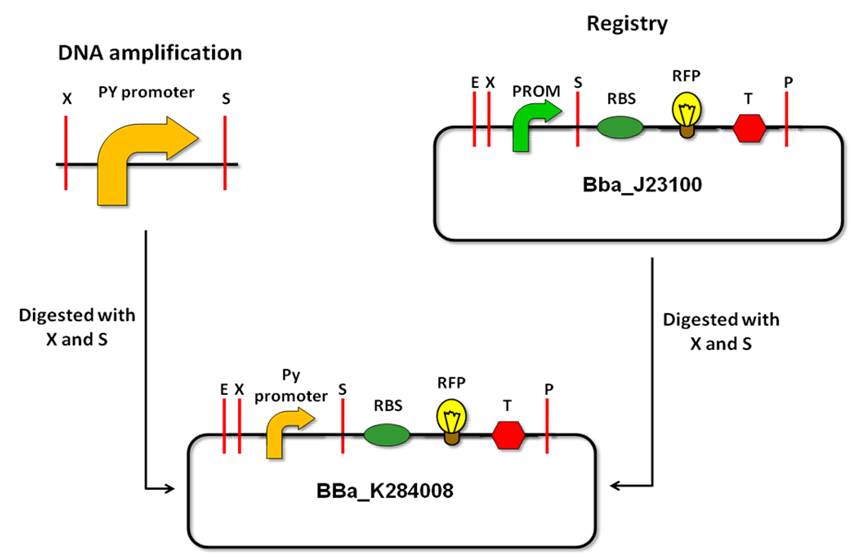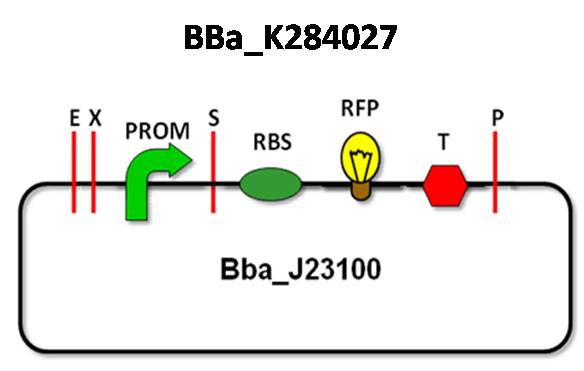Team:UNICAMP-Brazil/Coliguard/Recognition
From 2009.igem.org
(→Introduction) |
(→Py promoter cloning and characterization) |
||
| (4 intermediate revisions not shown) | |||
| Line 8: | Line 8: | ||
| - | *Why not create a continuous mechanism of eliminating contaminants? | + | *Why not create a continuous mechanism of eliminating contaminants? |
A simple way to do this would be to create bacteria that express a toxin constitutively. However, if the bacteria produce the toxin continuously, they will compromise their metabolic energy for the production of the toxic compound and, in addition, the production of large amounts of these antibiotic substances may contribute to the problem of antibiotic resistance. Moreover, the toxin itself would be a type of contaminant in the industrial process, requiring resources to be allocated in order to remove the toxin from the medium and purify the compound of interest. | A simple way to do this would be to create bacteria that express a toxin constitutively. However, if the bacteria produce the toxin continuously, they will compromise their metabolic energy for the production of the toxic compound and, in addition, the production of large amounts of these antibiotic substances may contribute to the problem of antibiotic resistance. Moreover, the toxin itself would be a type of contaminant in the industrial process, requiring resources to be allocated in order to remove the toxin from the medium and purify the compound of interest. | ||
| - | *Therefore, we need a contaminant-sensitive recognition system! | + | *Therefore, we need a contaminant-sensitive recognition system! |
We need to create a contaminant-sensitive mechanism that will allow the detection of the contaminants and trigger the killing mechanism. In this case, the toxin will be produced only when the contaminants are present. | We need to create a contaminant-sensitive mechanism that will allow the detection of the contaminants and trigger the killing mechanism. In this case, the toxin will be produced only when the contaminants are present. | ||
| - | *How will our bacterial guards recognize the contaminants? | + | *How will our bacterial guards recognize the contaminants? |
Our idea is based on the premise that the engineered ''E. coli'' must be able to recognize contaminants in the culture medium as non-self. Thus, our bacteria need to recognize a specific signal that they don’t produce, but which are broadly produced or presented by potential contaminants. Thinking about the potential signals, we found two candidates: the AI2 (auto inducer 2) and the conjugation recognition mechanism. | Our idea is based on the premise that the engineered ''E. coli'' must be able to recognize contaminants in the culture medium as non-self. Thus, our bacteria need to recognize a specific signal that they don’t produce, but which are broadly produced or presented by potential contaminants. Thinking about the potential signals, we found two candidates: the AI2 (auto inducer 2) and the conjugation recognition mechanism. | ||
| - | *Using AI-2 as a signal. How? | + | *Using AI-2 as a signal. How? |
As most bacterial species produces AI2 as a secondary metabolite(1; 2; 3), we decided to use this compound as a recognition factor. Our ''E. coli'' will be an AI2- strain and won´t produce native AI2. The presence of AI2 in the culture medium will then indicate the presence of contaminants, which will be recognized by an AI2 sensitive promoter present in our ''E. coli''. This promoter will control the differentiation and killing mechanisms (see the links for more information). | As most bacterial species produces AI2 as a secondary metabolite(1; 2; 3), we decided to use this compound as a recognition factor. Our ''E. coli'' will be an AI2- strain and won´t produce native AI2. The presence of AI2 in the culture medium will then indicate the presence of contaminants, which will be recognized by an AI2 sensitive promoter present in our ''E. coli''. This promoter will control the differentiation and killing mechanisms (see the links for more information). | ||
| - | *But, what if the contaminants do not produce AI-2? | + | *But, what if the contaminants do not produce AI-2? |
In these situations, our ''E.coli'' will use another recognition mechanism, based in conjugation. In conjugation, a donor bacterium only conjugates with organisms that don’t have the same conjugative plasmid. Bacteria that already have the plasmid display membrane proteins that prevent the conjugation with other bacteria that have the same conjugative plasmid (4). Therefore, if our ''E.coli'' has a conjugative plasmid, they will only conjugate with different organisms, which will be the contaminants. | In these situations, our ''E.coli'' will use another recognition mechanism, based in conjugation. In conjugation, a donor bacterium only conjugates with organisms that don’t have the same conjugative plasmid. Bacteria that already have the plasmid display membrane proteins that prevent the conjugation with other bacteria that have the same conjugative plasmid (4). Therefore, if our ''E.coli'' has a conjugative plasmid, they will only conjugate with different organisms, which will be the contaminants. | ||
| Line 35: | Line 35: | ||
We think that a better way to improve the recognition system is to combine the conjugation signal with the AI-2 recognition mechanism. | We think that a better way to improve the recognition system is to combine the conjugation signal with the AI-2 recognition mechanism. | ||
| - | |||
==Our recognition system: a combination of conjugation and the AI-2 recognition mechanism!== | ==Our recognition system: a combination of conjugation and the AI-2 recognition mechanism!== | ||
| Line 65: | Line 64: | ||
| - | == | + | ==Py promoter cloning and characterization== |
'''Strategy''' | '''Strategy''' | ||
| Line 84: | Line 83: | ||
In the characterization experiment, we will use a donor bacterium that carries an F plasmid with the ampicillin resistance gene. Thus, we can’t select transformed bacterial colonies with our device in a medium supplemented with ampicillin. Therefore, we cloned the BBa_K284008 part into the pSB1AK3 vector, which carries the ampicillin and kanamycin resistance genes. Then, we could select the colonies in a medium supplemented with kanamycin. | In the characterization experiment, we will use a donor bacterium that carries an F plasmid with the ampicillin resistance gene. Thus, we can’t select transformed bacterial colonies with our device in a medium supplemented with ampicillin. Therefore, we cloned the BBa_K284008 part into the pSB1AK3 vector, which carries the ampicillin and kanamycin resistance genes. Then, we could select the colonies in a medium supplemented with kanamycin. | ||
| - | |||
==Engineering the F plasmid – removing parts and adding new replication origins== | ==Engineering the F plasmid – removing parts and adding new replication origins== | ||
| Line 109: | Line 107: | ||
'''Constructions:''' | '''Constructions:''' | ||
| - | '''1)''' BBa_K284027 - ''QseA'' promoter | + | '''1)''' BBa_K284027 - ''QseA'' promoter |
This part will be constructed using the standard assembly strategy. After the amplification of the ''QseA'' promoter the part will be joined with the Bba_J23100 plasmid for characterization. | This part will be constructed using the standard assembly strategy. After the amplification of the ''QseA'' promoter the part will be joined with the Bba_J23100 plasmid for characterization. | ||
| Line 116: | Line 114: | ||
| - | '''2)''' BBa_K284028 – LuxS under the control of ''Py'' promoter | + | '''2)''' BBa_K284028 – LuxS under the control of ''Py'' promoter |
This device will be composed of BBa_K284008 (Py promoter), BBa_B0034 (a RBS), BBa_K091109 (LuxS) and BBa_0014 (a double terminator) and constructed following the standard assembly strategy. | This device will be composed of BBa_K284008 (Py promoter), BBa_B0034 (a RBS), BBa_K091109 (LuxS) and BBa_0014 (a double terminator) and constructed following the standard assembly strategy. | ||
| Line 122: | Line 120: | ||
[[Image:Imagem3.jpg|center|400px]] | [[Image:Imagem3.jpg|center|400px]] | ||
| - | '''3)''' BBa_K284029 – CRE-recombinase under the control of ''QseA'' promoter | + | '''3)''' BBa_K284029 – CRE-recombinase under the control of ''QseA'' promoter |
This device will be composed of BBa_K28402 (QseA promoter), BBa_B0034 (a RBS), BBa_J61047 (CRE-recombinase) and BBa_0014 (a double terminator) and constructed according to the standard assembly strategy. | This device will be composed of BBa_K28402 (QseA promoter), BBa_B0034 (a RBS), BBa_J61047 (CRE-recombinase) and BBa_0014 (a double terminator) and constructed according to the standard assembly strategy. | ||
Latest revision as of 03:17, 22 October 2009
| ||||||||||||||||||||||||||||||||||
 "
"


















